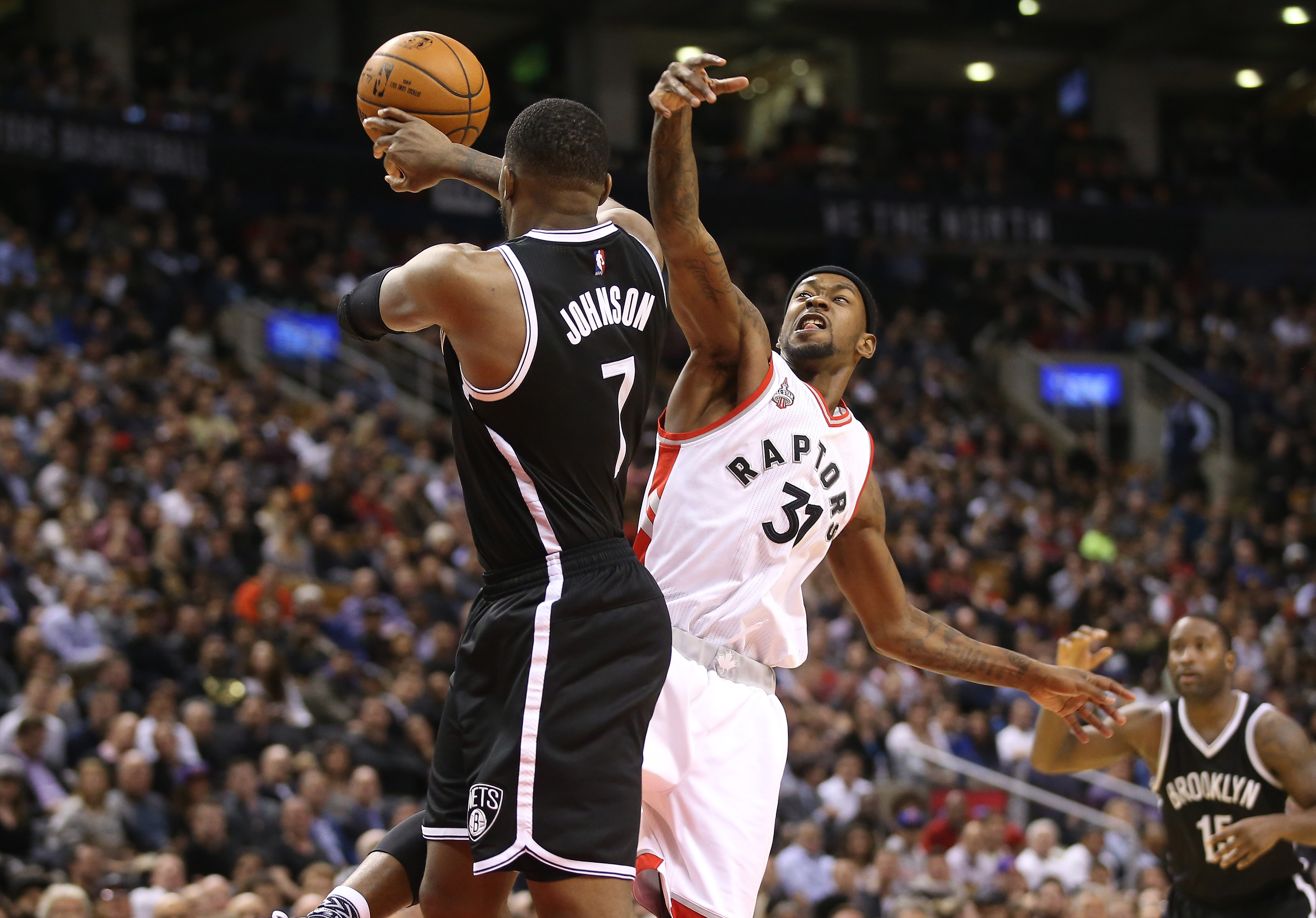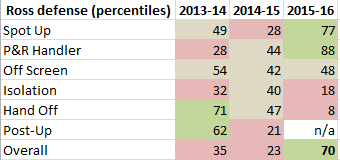After nearly four seasons, 272 games, and 6,314 minutes played, Terrence Ross remains somewhat of a mystery.
There is no descriptor about him that feels regularly appropraite beyond “inconsistent,” and the maddening up-and-down not just in his play but in the general buy-in to Ross as a capable player makes evaluating the team and his place on it difficult. When he’s good, the Raptors look like they have the wing depth to survive an extended DeMarre Carroll absence and to play small and spacy when he returns, without much wing slippage when starters sit. When he’s bad, the Raptors’ lack of depth is magnified and it becomes tough to pencil Ross in for any meaningful role come playoff time or moving forward.
It certainly doesn’t help matters that Ross signed a three-year, $31-million contract extension before the season and immediately fell into a prolonged slump. Increased expectations and terrible early two-way performance led some to anchor in their positions and left others grasping for reasons for optimism.
Those willing to keep the faith have been rewarded, as Ross has played well for the most part since Carroll went down the second of three times on Dec. 7. In 21 games since, Ross is averaging 10.3 points on 46.6 percent from the floor, knocking down 40 percent of his threes, and, most notably, stepping up his defense. The offensive contributions are easy to see and understand – the team desperately needs the spacing he provides when he joins the starters, and the second unit needs his improved but still shaky ability to create for himself. The team’s offense has still been better without him overall because of occasional bench scoring issues, but his play has markedly improved at that end. He’s a far cry from being efficient, still, given how well he has to shoot to make up for offering little else on offense, but it’s been encouraging – that shooting is really important, with or without Carroll.
Perhaps more important in Carroll’s absence is that Ross’ defensive play has improved along with the offense. At least, it’s looked like it has.
He’s seemed far more engaged, something he expected since hitting shots can help get a player more comfortable in the overall flow of the game. He also seems to be making fewer mistakes in pick-and-roll coverage, long a Ross specialty, and he’s using his athleticism and quickness to cause havoc, snuffing out transition runs and jumping passing lanes for steals. He’s done a great job at times – usually when he plays with Kyle Lowry without Cory Joseph on the floor – of handling opposing point guards, a welcome wrinkle to his defense. He doesn’t have the size to guard bigger small forwards, but he has the quickness to help slow down drives or keep ball-handlers in front of him; he’s not Kentavious Caldwell-Pope or anything, but if he can help Lowry out in that regard, that’s a big development.
Ross is still occasionally uneven at that end of the floor, because this is Terrence Ross, and no analysis can ever be simple with him. There’s also the matter of the Raptors’ defense not being all that good lately as a team – they rank 11th in defensive efficiency with 101.1 PPC allowed overall but have been mediocre for three games running on that end, surrendering 104.5 PPC to teams that rank 19th, 25th, and 28th in offense.
Encouraging from those games? The team has only given up 94.2 PPC when Ross is on the floor. It’s a tiny sample and Ross has gotten heavy run against reserves, but it continues a season-long trend: The Raptors have been 4.9 PPC better on defense with Ross on the floor and 3.2 PPC better with him overall.
There are caveats. Ross plays 57.4 percent of his minutes with Lowry, and the team’s been outscored with Lowry off and Ross on, something that holds true for most every player and Lowry. In a small sample (177 minutes) without Lowry or Bismack Biyombo, lineups with Ross have bled on defense (as mentioned a few times here lately, DeMar DeRozan-led bench units have really struggled). Ross also plays heavily sheltered minutes, playing opposite 2.56 starters on average, per Nylon Calculus (he’s actually shot far better against starter-heavy units, a weird bit of variance I thought I’d point out while here).
In terms of overall impact, despite the on-off numbers, DRE grades Ross as below-average and Real Plus-Minus views him as a negative at both ends. Defensive BPM isn’t a fan, either. It isn’t as if Ross is moving the needle a great deal,and a lot of these numbers are difficult to extract from their context. So far, numbers suggest a bit of a mixed bag, which is why defense often relies on qualitative information.
Still, there are signs Ross’ defense is making an impact. Six of the Raptors’ 10 best defensive lineups (minimum 20 minutes played) include Ross, including the team’s best defensive look (Lowry-and-bench). He grades out well for a wing by rim protection numbers (shout out to James Johnson), per Nylon Calculus. And there’s the matter of this: Opponents are shooting worse in every area of the floor when Ross is their primary defender, per NBA.com.
Opponent field-goal numbers are tough to assign to a single player and this is by no means a mic drop. It could be noise over 35 games and 796 minutes. It could be the result of the scheme or good defenders around him. Like with the negatives, it’s tough to pull the positives out from the context in which they exist.
Still, it’s encouraging, and there are more numbers suggesting Ross is having an impact. Going back to Nylon Calculus (thank shammgod for Seth Partnow and the gang), Ross is allowing the best “opponent matchup production” on the team – his matchup averages just 12.8 points, 4.6 rebounds, and 3.2 assists per-36 minutes with a team-best 47.2 true-shooting percentage. The result? A team best -3.06 DRE per-36 for his matchup (that number probably doesn’t mean much to you, but it’s a good mark). Partnow has been messing around with the defensive impact a player has on his matchup, and Ross’ -3.06 ranks fifth in the NBA.
Messing w/ some matchup stuff, these don’t seem like terrible lists of positive(green) and negative(red) def impact pic.twitter.com/4BkrNdCYv5
— Seth Partnow (@SethPartnow) January 21, 2016
Those numbers aren’t controlled for quality of competition, and again, Ross plays pretty sheltered minutes.
But again, this is all encouraging, in part because Ross has the physical tools to be a good defender and a contract that will soon pay him like one. He’s shown extended flashes of defensive potential before. It looks silly in retrospect, but at this time two years ago, Ross was grading out well as an isolation defender and spoke with Raptors Republic about his motivation and desire to be a stopper on that end. The rest of his 2013-14 didn’t play out that way, as he regressed a great deal, and his 2014-15 was mostly disappointing.
This year, though, Ross is making strides. Per Synergy Sports data provided to Raptors Republic, Ross not only grades out as above-average overall, but is reaching the upper echelon defending spot-up shooters (his quickness and athleticism for aggressive closeouts) and in guarding pick-and-roll ball-handlers (as discussed), his two primary assignments. He’s struggling on the rare instances he’s isolated (20 on the year) and continues to be middling when chasing guys off-ball, which also matches what we’ve seen from him.
So what’s one to conclude from all of this information? The honest answer is I don’t really know. My eyes told me that Ross has been playing much better at the defensive end of the floor, so I tried to dig into the data to see if I was right, wrong, or somewhere in between. Synergy and opponent production data help back up what I was seeing, and the team’s been better with him out there, but more advanced metrics don’t necessarily see it (or, at least, credit him for it). In either case, positive or negative, it remains difficult in just 800 minutes to suss out the individual performance from the contributions of teammates or the quality of competition (this is something NHL analytics have done a nice job striving to do).
In this case, I’m choosing to remain encouraged. Ross has always been someone who should be a good defender, and he’s flashed it, but he’s been wildly inconsistent. It’s only been about six weeks of Ross playing well at that end, so you’re within your rights to expect regression. Hope for the opposite, though, because if Ross is actually going to land somewhere north of average on the defensive end and continue to sniff 40 percent from long range, well, that contract might look a little more palatable after this summer.






